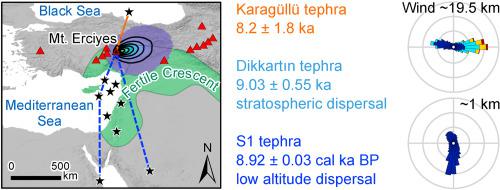当前位置:
X-MOL 学术
›
Quat. Sci. Rev.
›
论文详情
Our official English website, www.x-mol.net, welcomes your feedback! (Note: you will need to create a separate account there.)
New insights into source and dispersal of Mediterranean S1 tephra, an early Holocene marker horizon erupted at Mt. Erciyes (Turkey)
Quaternary Science Reviews ( IF 4 ) Pub Date : 2020-12-01 , DOI: 10.1016/j.quascirev.2020.106606 Bjarne Friedrichs , Julie C. Schindlbeck-Belo , Martin Danišík , Susanna F. Jenkins , Esra Yurteri , Mehmet Çobankaya , Matthias Frische , Kuo-Lung Wang , Hao-Yang Lee , Gokhan Atıcı , Axel K. Schmitt , R. Stephen J. Sparks
Quaternary Science Reviews ( IF 4 ) Pub Date : 2020-12-01 , DOI: 10.1016/j.quascirev.2020.106606 Bjarne Friedrichs , Julie C. Schindlbeck-Belo , Martin Danišík , Susanna F. Jenkins , Esra Yurteri , Mehmet Çobankaya , Matthias Frische , Kuo-Lung Wang , Hao-Yang Lee , Gokhan Atıcı , Axel K. Schmitt , R. Stephen J. Sparks

|
Abstract Deposition of early Holocene Eastern Mediterranean S1 tephra and a Black Sea cryptotephra coincides with cultural transitions in the Fertile Crescent termed the Neolithic Revolution as well as sapropel formation during climate variability of the African humid period, classifying them as paramount regional marker horizons for archaeology as well as paleoclimatology. Their correlations with specific eruptions of the Mt. Erciyes stratovolcanic complex (Central Anatolia) remained inconclusive though. Here, we use zircon double-dating by (U–Th)/He and U–Th disequilibrium methods, major and trace element tephra glass geochemistry, and probabilistic modeling of tephra dispersal in an attempt to characterize all major late Quaternary proximal tephras of Mt. Erciyes, and to correlate them with distal deposits. Furthermore, we discuss contrasting proximal and distal tephra dispersal. Three nearly-coeval rhyolitic satellite domes (Dikkartin, Perikartin, and Karagullu) erupted at Mt. Erciyes in the early Holocene, and their dome extrusions were all preceded by explosive phases producing pyroclastic material that formed tephra fall and pyroclastic flow deposits. The new eruption age of 9.03 ± 0.55 ka (1σ uncertainty here and elsewhere) for proximal Dikkartin pumice is consistent with 14C-based S1 tephra chronologies in distal locations averaging 8.92 ± 0.03 cal ka BP. Perikartin pyroclastic flow deposits predate S1 tephra by ca. 0.8 ka according to a pair of published 14C ages, and stratigraphically overlie Karagullu fall-out, here dated to 8.2 ± 1.8 ka. Previously undated proximal tephras of Mt. Erciyes erupted in the Late (85.2 ± 4.9 ka) and Middle Pleistocene (154.5 ± 5.3 ka). S1 tephra glass is chemically similar to that of Dikkartin fall-out, but also indistinguishable from that of Perikartin fall-out. Karagullu pumice is characterized by a distinct glass chemical composition, which correlates with that of unnamed cryptotephra reported for the southeastern Black Sea instead, where these results call for a re-evaluation of existing age models. Maximum lithic clast size isopleths for proximal Dikkartin fall-out indicate eastward dispersal of a 20 ± 5 km high eruption plume by stratospheric winds, in agreement with results of probabilistic tephra dispersal modeling. This azimuth contrasts with the known distribution of S1 tephra at distal locations that are all south of Mt. Erciyes. Significant tephra occurrences at up to 1300 km distance and orthogonal to prevalent stratospheric wind directions either result from very atypical wind conditions (probability ≪10 %), or are caused by tephra transport by prevailing low altitude winds. Two scenarios are proposed for low altitude transport: eolian reworking of primary fall-out (more likely from the more widespread Dikkartin deposits), or co-ignimbrite ash cloud dispersal (more likely from the Perikartin eruption which predominantly produced pyroclastic flows). Because S1 tephra is chemically indistinguishable from both Dikkartin and Perikartin by major and trace element glass compositions, its exact source and dispersal mechanism remain ambiguous, although existing 14C ages for Perikartin predating those for S1 tephra favor Dikkartin as its source.
中文翻译:

对地中海 S1 tephra 的来源和扩散的新见解,这是一个在 Mt. 火山爆发的早期全新世标记地平线。埃尔西耶斯(土耳其)
摘要 全新世早期东地中海 S1 火山灰和黑海隐藻的沉积与被称为新石器时代革命的肥沃新月区的文化转变以及非洲湿润期气候变化期间腐泥形成相吻合,将它们归类为考古学最重要的区域标记视野以及古气候学。它们与山的特定喷发的相关性。Erciyes 成层火山复合体(安纳托利亚中部)仍然没有定论。在这里,我们通过 (U-Th)/He 和 U-Th 不平衡方法、主要和微量元素火山灰玻璃地球化学以及火山灰扩散的概率建模使用锆石双重定年,试图表征 Mt 的所有主要晚第四纪近端火山灰. Erciyes,并将它们与远端沉积物相关联。此外,我们讨论对比近端和远端的火山灰扩散。三个几乎同时代的流纹质卫星圆顶(Dikkartin、Perikartin 和 Karagullu)在 Mt. 火山喷发。全新世早期的 Erciyes 及其圆顶挤压物都在爆炸阶段之前产生火山碎屑物质,形成火山灰坠落和火山碎屑流沉积物。近端 Dikkartin 浮石的新喷发年龄为 9.03 ± 0.55 ka(此处和其他地方的 1σ 不确定性)与远端位置的基于 14C 的 S1 tephra 年代学一致,平均为 8.92 ± 0.03 cal ka BP。Perikartin 火山碎屑流沉积物早于 S1 tephra 约。根据一对已发表的 14C 年代为 0.8 ka,地层上覆盖了 Karagullu 沉降物,这里的年代为 8.2 ± 1.8 ka。以前未注明日期的山的近端 tephras。Erciyes 在晚 (85.2 ± 4.9 ka) 和中更新世 (154. 5 ± 5.3 ka)。S1 tephra 玻璃在化学上与 Dikkartin 沉降物相似,但与 Perikartin 沉降物也无法区分。Karagullu 浮石的特点是具有独特的玻璃化学成分,这与在黑海东南部报道的未命名隐石的成分相关,这些结果要求重新评估现有的年龄模型。近端 Dikkartin 沉降物的最大岩屑大小等值线表明平流层风向东扩散了 20 ± 5 公里高的喷发羽流,这与概率火山灰扩散模型的结果一致。这个方位角与 S1 tephra 在所有位于 Mt. 南部的远端位置的已知分布形成对比。埃尔西耶斯。在长达 1300 公里的距离并与盛行的平流层风向正交的显着火山灰发生要么是由于非常非典型的风况(概率 ≪ 10 %)造成的,要么是由盛行的低空风传播的火山灰造成的。为低空运输提出了两种方案:初级沉降物的风成再加工(更可能来自更广泛的迪卡廷沉积物),或共同燃烧的灰云扩散(更可能来自主要产生火山碎屑流的佩里卡廷喷发)。由于 S1 tephra 在化学上无法通过主要和微量元素玻璃成分与 Dikartin 和 Perikartin 进行区分,因此其确切来源和扩散机制仍然不明确,尽管 Perikartin 的 14C 年龄早于 S1 tephra 的 14C 年龄倾向于 Dikkartin 作为其来源。
更新日期:2020-12-01
中文翻译:

对地中海 S1 tephra 的来源和扩散的新见解,这是一个在 Mt. 火山爆发的早期全新世标记地平线。埃尔西耶斯(土耳其)
摘要 全新世早期东地中海 S1 火山灰和黑海隐藻的沉积与被称为新石器时代革命的肥沃新月区的文化转变以及非洲湿润期气候变化期间腐泥形成相吻合,将它们归类为考古学最重要的区域标记视野以及古气候学。它们与山的特定喷发的相关性。Erciyes 成层火山复合体(安纳托利亚中部)仍然没有定论。在这里,我们通过 (U-Th)/He 和 U-Th 不平衡方法、主要和微量元素火山灰玻璃地球化学以及火山灰扩散的概率建模使用锆石双重定年,试图表征 Mt 的所有主要晚第四纪近端火山灰. Erciyes,并将它们与远端沉积物相关联。此外,我们讨论对比近端和远端的火山灰扩散。三个几乎同时代的流纹质卫星圆顶(Dikkartin、Perikartin 和 Karagullu)在 Mt. 火山喷发。全新世早期的 Erciyes 及其圆顶挤压物都在爆炸阶段之前产生火山碎屑物质,形成火山灰坠落和火山碎屑流沉积物。近端 Dikkartin 浮石的新喷发年龄为 9.03 ± 0.55 ka(此处和其他地方的 1σ 不确定性)与远端位置的基于 14C 的 S1 tephra 年代学一致,平均为 8.92 ± 0.03 cal ka BP。Perikartin 火山碎屑流沉积物早于 S1 tephra 约。根据一对已发表的 14C 年代为 0.8 ka,地层上覆盖了 Karagullu 沉降物,这里的年代为 8.2 ± 1.8 ka。以前未注明日期的山的近端 tephras。Erciyes 在晚 (85.2 ± 4.9 ka) 和中更新世 (154. 5 ± 5.3 ka)。S1 tephra 玻璃在化学上与 Dikkartin 沉降物相似,但与 Perikartin 沉降物也无法区分。Karagullu 浮石的特点是具有独特的玻璃化学成分,这与在黑海东南部报道的未命名隐石的成分相关,这些结果要求重新评估现有的年龄模型。近端 Dikkartin 沉降物的最大岩屑大小等值线表明平流层风向东扩散了 20 ± 5 公里高的喷发羽流,这与概率火山灰扩散模型的结果一致。这个方位角与 S1 tephra 在所有位于 Mt. 南部的远端位置的已知分布形成对比。埃尔西耶斯。在长达 1300 公里的距离并与盛行的平流层风向正交的显着火山灰发生要么是由于非常非典型的风况(概率 ≪ 10 %)造成的,要么是由盛行的低空风传播的火山灰造成的。为低空运输提出了两种方案:初级沉降物的风成再加工(更可能来自更广泛的迪卡廷沉积物),或共同燃烧的灰云扩散(更可能来自主要产生火山碎屑流的佩里卡廷喷发)。由于 S1 tephra 在化学上无法通过主要和微量元素玻璃成分与 Dikartin 和 Perikartin 进行区分,因此其确切来源和扩散机制仍然不明确,尽管 Perikartin 的 14C 年龄早于 S1 tephra 的 14C 年龄倾向于 Dikkartin 作为其来源。



























 京公网安备 11010802027423号
京公网安备 11010802027423号